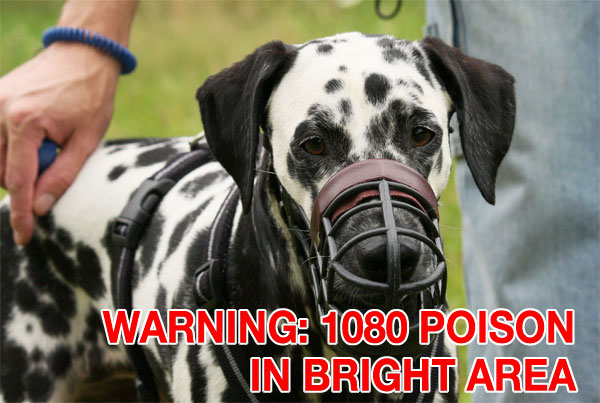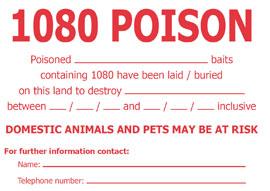MORE NEWS...
Use the portal below to browse all news items back to 2011 without leaving this page. You can also filter news by topics, or use the Search form to search by keywords. Note that using the search form will search the entire site and present search results in a new page.
Danger for Dogs: 1080 poison in Bright area
Dr. Bek and Alpine Animal Doctors would like to warn pet owners in Bright/Porepunkah that the Department of Environment and Primary Industries will undertake a 1080 poisoning programme in the area from 20 August 2013 through to 12 November 2013.
 Dr. Bek and Alpine Animal Doctors would like to warn pet owners in Bright/Porepunkah that the Department of Environment and Primary Industries will undertake a 1080 poisoning programme in the area from 20 August 2013 through to 12 November 2013. All tracks to be baited will be clearly signposted with warnings similar to the illustration below.
Dr. Bek and Alpine Animal Doctors would like to warn pet owners in Bright/Porepunkah that the Department of Environment and Primary Industries will undertake a 1080 poisoning programme in the area from 20 August 2013 through to 12 November 2013. All tracks to be baited will be clearly signposted with warnings similar to the illustration below.
Pet owners should exercise extreme caution and keep dogs and cats well away from areas with poison baits during the programme, and for some time afterwards.
If you must walk your dog in baited areas ensure that they are wearing a muzzle to prevent them finding and eating any baits.
1080 is a restricted schedule 7 poison for which there is no known antidote. Dogs are particularly susceptible and the ingestion of even small amounts of 1080 baits is always very serious, and frequently fatal.
If you see your dog eat a poison bait, or a dead or dying poisoned pest animal, or even suspect they may have ingested baits, call the hospital immediately, (03 5756 2444) day or night, and get your pet to us, or the nearest vet, as quickly as possible. Do not wait until signs of poisoning appear. Swift action is essential if we are to have any chance of saving your pet’s life.
While there are treatments we can use, once clear signs of poisoning are apparent the prognosis is poor. Initial signs to watch for are:
- anxiety;
- frenzied behaviour such as howling or running;
- hypersensitivity to sound or light;
- failure to respond to owner
- vomiting;
- uncontrolled urinating and defecating.
Without rapid action and treatment, symptoms will progress to:
- convulsions;
- difficulty in breathing;
- respiratory failure;
- coma;
- death.
What if I can’t get to a vet?
If you cannot promptly get a pet with suspected poisoning to a vet clinic, or you know there will be a delay, you can try to induce vomiting. This must be done immediately after ingestion. But be aware that is not easy for an untrained individual to successfully get a dog or cat to vomit. You also risk getting the emetic into your dog’s lungs and causing asphyxiation, or administering too much emetic and causing critical illness.
Please take great care in attempting to induce vomiting and if it is proving difficult do not waste time in repeated attempts — get the animal to a vet!
Suitable emetics are table salt (2 tablespoons in a cup of water, less for small dogs, more for large breeds) or 3-5 individual washing soda crystals (sodium carbonate). Do not use laundry detergents or washing powders.
If you succeed in inducing vomiting either bury the vomit deeply or remove it from the scene completely to prevent other animals being poisoned.
Even if you can get your pet to vomit it is unlikely to be completely out of danger and it’s vital that you still seek veterinary attention as quickly as possible.
As with all cases of poisoning, prevention is far better than cure. The simplest and safest way to ensure your pet is not poisoned by 1080 baits is to keep them well away from all baited areas.
